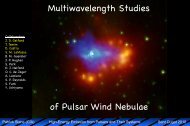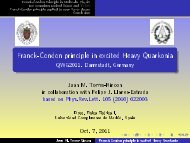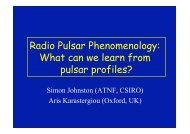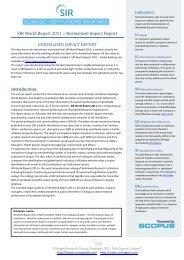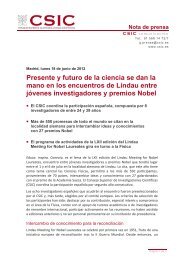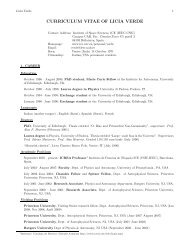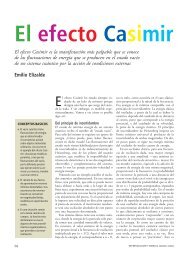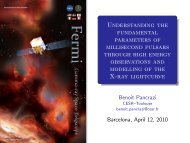On the modeling of Intermediate- and Extreme-Mass-Ratio Inspirals
On the modeling of Intermediate- and Extreme-Mass-Ratio Inspirals
On the modeling of Intermediate- and Extreme-Mass-Ratio Inspirals
You also want an ePaper? Increase the reach of your titles
YUMPU automatically turns print PDFs into web optimized ePapers that Google loves.
<strong>On</strong> <strong>the</strong> <strong>modeling</strong> <strong>of</strong> <strong>Intermediate</strong>- <strong>and</strong><br />
<strong>Extreme</strong>-<strong>Mass</strong>-<strong>Ratio</strong> <strong>Inspirals</strong><br />
Carlos F. Sopuerta<br />
Institute <strong>of</strong> Space Sciences (CSIC-IEEC)<br />
2nd Iberian Gravitational Wave Meeting [February 16th, 2012]<br />
1
Outline<br />
Introduction to IMRIs <strong>and</strong> EMRIs<br />
Review <strong>of</strong> <strong>modeling</strong> techniques <strong>and</strong> key<br />
Results<br />
A new Method: The Chimera Scheme<br />
Some Conclusions <strong>and</strong> Future Work<br />
2nd Iberian Gravitational Wave Meeting [February 16th, 2012]<br />
2
Introduction to IMRIs <strong>and</strong> EMRIs<br />
<strong>Intermediate</strong>- <strong>and</strong> <strong>Extreme</strong> mass ratio inspirals (IMRIs <strong>and</strong><br />
EMRIs) are binary systems whose evolution is driven by<br />
Gravitational-Wave (GW) emission <strong>and</strong> such <strong>the</strong> mass ratio<br />
between <strong>the</strong>ir components is in <strong>the</strong> range:<br />
q = m ∗<br />
M •<br />
=<br />
∼ 10 −7 − 10 −4<br />
∼ 10 −4 − 10 −2<br />
for EMRIs<br />
for IMRIs<br />
2nd Iberian Gravitational Wave Meeting [February 16th, 2012] 3
Introduction to IMRIs <strong>and</strong> EMRIs<br />
<strong>Intermediate</strong>- <strong>and</strong> <strong>Extreme</strong> mass ratio inspirals (IMRIs <strong>and</strong><br />
EMRIs) are binary systems whose evolution is driven by<br />
Gravitational-Wave (GW) emission <strong>and</strong> such <strong>the</strong> mass ratio<br />
between <strong>the</strong>ir components is in <strong>the</strong> range:<br />
q = m ∗<br />
M •<br />
=<br />
∼ 10 −7 − 10 −4<br />
∼ 10 −4 − 10 −2<br />
for EMRIs<br />
for IMRIs<br />
The main MOTIVATION to study IMRI/EMRIs is that <strong>the</strong>y<br />
are important sources <strong>of</strong> GWs for space-based observatories,<br />
like eLISA/NGO, <strong>and</strong> also for advanced (LIGO, VIRGO,<br />
KAGRA) <strong>and</strong> third-generation ground-based detectors (ET).<br />
2nd Iberian Gravitational Wave Meeting [February 16th, 2012] 3
Introduction to IMRIs <strong>and</strong> EMRIs<br />
These systems, given that <strong>the</strong>y are defined by mass ratios<br />
beyond 1:100, necessarily must involve Black Holes (BHs).<br />
2nd Iberian Gravitational Wave Meeting [February 16th, 2012] 4
Introduction to IMRIs <strong>and</strong> EMRIs<br />
These systems, given that <strong>the</strong>y are defined by mass ratios<br />
beyond 1:100, necessarily must involve Black Holes (BHs).<br />
More specifically: The systems we have in mind are:<br />
* EMRIs : Stellar Compact Object (SCO) + <strong>Mass</strong>ive BH (MBH)<br />
(Space-Based Detectors)<br />
* IMRIs : SCO + <strong>Intermediate</strong>-<strong>Mass</strong> BH (IMBH)<br />
(Ground-Based Detectors)<br />
IMBH + MBH (Space-Based Detectors)<br />
2nd Iberian Gravitational Wave Meeting [February 16th, 2012] 4
Introduction to IMRIs <strong>and</strong> EMRIs<br />
These systems, given that <strong>the</strong>y are defined by mass ratios<br />
beyond 1:100, necessarily must involve Black Holes (BHs).<br />
More specifically: The systems we have in mind are:<br />
* EMRIs : Stellar Compact Object (SCO) + <strong>Mass</strong>ive BH (MBH)<br />
(Space-Based Detectors)<br />
* IMRIs : SCO + <strong>Intermediate</strong>-<strong>Mass</strong> BH (IMBH)<br />
(Ground-Based Detectors)<br />
IMBH + MBH (Space-Based Detectors)<br />
Number <strong>of</strong> GW Cycles ∼ q −1<br />
2nd Iberian Gravitational Wave Meeting [February 16th, 2012] 4
Introduction to IMRIs <strong>and</strong> EMRIs<br />
After many years <strong>of</strong> observations <strong>the</strong> existence <strong>of</strong> stellarmass<br />
black holes (~4-50 solar masses) <strong>and</strong> (super)massive<br />
black holes (~100000 to billion solar masses ) has been<br />
established with a high degree <strong>of</strong> confidence.<br />
2nd Iberian Gravitational Wave Meeting [February 16th, 2012] 5
Introduction to IMRIs <strong>and</strong> EMRIs<br />
After many years <strong>of</strong> observations <strong>the</strong> existence <strong>of</strong> stellarmass<br />
black holes (~4-50 solar masses) <strong>and</strong> (super)massive<br />
black holes (~100000 to billion solar masses ) has been<br />
established with a high degree <strong>of</strong> confidence.<br />
There is a gap in <strong>the</strong> BH mass range, between ~100 to several<br />
10000 solar masses, where <strong>the</strong>re is not yet a strong<br />
observational evidence. The BHs in this mass range cannot<br />
have nei<strong>the</strong>r stellar origin nor primordial (early universe).<br />
These are <strong>the</strong> <strong>Intermediate</strong>-<strong>Mass</strong> BHs (IMBHs).<br />
2nd Iberian Gravitational Wave Meeting [February 16th, 2012] 5
Introduction to IMRIs <strong>and</strong> EMRIs<br />
After many years <strong>of</strong> observations <strong>the</strong> existence <strong>of</strong> stellarmass<br />
black holes (~4-50 solar masses) <strong>and</strong> (super)massive<br />
black holes (~100000 to billion solar masses ) has been<br />
established with a high degree <strong>of</strong> confidence.<br />
There is a gap in <strong>the</strong> BH mass range, between ~100 to several<br />
10000 solar masses, where <strong>the</strong>re is not yet a strong<br />
observational evidence. The BHs in this mass range cannot<br />
have nei<strong>the</strong>r stellar origin nor primordial (early universe).<br />
These are <strong>the</strong> <strong>Intermediate</strong>-<strong>Mass</strong> BHs (IMBHs).<br />
Therefore, <strong>the</strong>re is no observational evidence that supports <strong>the</strong><br />
existence <strong>of</strong> IMRIs, whereas <strong>the</strong> possible existence <strong>of</strong> EMRIs is<br />
sound <strong>and</strong> <strong>the</strong> uncertainties are related to formation<br />
mechanisms <strong>and</strong> <strong>the</strong>ir associated event rates.<br />
2nd Iberian Gravitational Wave Meeting [February 16th, 2012] 5
Introduction to IMRIs <strong>and</strong> EMRIs<br />
Why is this Mainly because it is extremely difficult to<br />
find dynamical evidence for IMBHs by looking at <strong>the</strong> most<br />
probable host scenarios: globular clusters <strong>and</strong> Ultra<br />
Luminous X-ray sources (ULXs).<br />
Cygnus X-1<br />
Sgr A*<br />
2nd Iberian Gravitational Wave Meeting [February 16th, 2012] 6
Introduction to IMRIs <strong>and</strong> EMRIs<br />
However, <strong>the</strong>re are several claims in <strong>the</strong> literature about <strong>the</strong><br />
presence <strong>of</strong> IMBHs in several systems, e.g.:<br />
S.A. Farrell, N.A. Webb, D. Barret, O. Godet & J.M. Rodrigues An intermediate-mass black<br />
hole <strong>of</strong> over 500 solar masses in <strong>the</strong> galaxy ESO 243-49, Nature 460, 73-75 (2 July 2009)<br />
Discovery <strong>of</strong> a variable ULX in <strong>the</strong> edge-on spiral galaxy ESO<br />
243–49. The extreme luminosity <strong>of</strong> <strong>the</strong> source (HLX-1) is<br />
consistent with <strong>the</strong> presence <strong>of</strong> an IMBH <strong>of</strong> more than 500<br />
solar masses<br />
2nd Iberian Gravitational Wave Meeting [February 16th, 2012] 7
Introduction to IMRIs <strong>and</strong> EMRIs<br />
Astrophysical mechanisms to produce EMRIs: The best<br />
studied one is <strong>the</strong> “Single Capture” mechanism:<br />
Scattering <strong>of</strong> a Stellar-mass<br />
Compact Object (through 2-body or<br />
multi-body encounters) to highly<br />
eccentric orbits around a MBH:<br />
M • ∼ 10 5 − 10 7 M ⊙ , 1 − e ∼ 10 −3 − 10 −6 .<br />
They expend <strong>the</strong> last year before<br />
plunging inside <strong>the</strong> eLISA b<strong>and</strong>:<br />
e ∼ 0.5 − 0.9 , no. cycles ∼ 10 5 .<br />
2nd Iberian Gravitational Wave Meeting [February 16th, 2012] 8
Introduction to IMRIs <strong>and</strong> EMRIs<br />
O<strong>the</strong>r Mechanisms:<br />
Stellar-<strong>Mass</strong> Compact Binaries passing close to <strong>the</strong> MBH<br />
can be tidally separated. <strong>On</strong>e component gets bound to <strong>the</strong><br />
MBH <strong>and</strong> <strong>the</strong> o<strong>the</strong>r one escapes to infinity.<br />
2nd Iberian Gravitational Wave Meeting [February 16th, 2012] 9
Introduction to IMRIs <strong>and</strong> EMRIs<br />
O<strong>the</strong>r Mechanisms:<br />
Stellar-<strong>Mass</strong> Compact Binaries passing close to <strong>the</strong> MBH<br />
can be tidally separated. <strong>On</strong>e component gets bound to <strong>the</strong><br />
MBH <strong>and</strong> <strong>the</strong> o<strong>the</strong>r one escapes to infinity.<br />
Capture <strong>of</strong> cores <strong>of</strong> giant stars close to <strong>the</strong> MBH by tidal<br />
stresses.<br />
2nd Iberian Gravitational Wave Meeting [February 16th, 2012] 9
Introduction to IMRIs <strong>and</strong> EMRIs<br />
O<strong>the</strong>r Mechanisms:<br />
Stellar-<strong>Mass</strong> Compact Binaries passing close to <strong>the</strong> MBH<br />
can be tidally separated. <strong>On</strong>e component gets bound to <strong>the</strong><br />
MBH <strong>and</strong> <strong>the</strong> o<strong>the</strong>r one escapes to infinity.<br />
Capture <strong>of</strong> cores <strong>of</strong> giant stars close to <strong>the</strong> MBH by tidal<br />
stresses.<br />
Inspiral <strong>of</strong> black holes produced in an accretion disc<br />
around <strong>the</strong> MBH (at distances ~ 0.1-1 pc).<br />
2nd Iberian Gravitational Wave Meeting [February 16th, 2012] 9
Introduction to IMRIs <strong>and</strong> EMRIs<br />
The orbits probe <strong>the</strong> strong-field region <strong>of</strong> <strong>the</strong> central MBH:<br />
2nd Iberian Gravitational Wave Meeting [February 16th, 2012] 10
Introduction to IMRIs <strong>and</strong> EMRIs<br />
Astrophysical Mechanisms for IMRIs:<br />
Dense clusters <strong>of</strong> stars -> Runaway Collisions <strong>and</strong> IMBH<br />
formation. IMRIs come from capture <strong>of</strong> stellar objects.<br />
2nd Iberian Gravitational Wave Meeting [February 16th, 2012] 11
Introduction to IMRIs <strong>and</strong> EMRIs<br />
Astrophysical Mechanisms for IMRIs:<br />
Dense clusters <strong>of</strong> stars -> Runaway Collisions <strong>and</strong> IMBH<br />
formation. IMRIs come from capture <strong>of</strong> stellar objects.<br />
Gravitational collapse <strong>of</strong> Population III stars at <strong>the</strong> early<br />
universe to form IMBHs.<br />
2nd Iberian Gravitational Wave Meeting [February 16th, 2012] 11
Detectability:<br />
Introduction to IMRIs <strong>and</strong> EMRIs<br />
IMRI signals are stronger than EMRI ones but sweep in <strong>the</strong><br />
b<strong>and</strong> faster too.<br />
2nd Iberian Gravitational Wave Meeting [February 16th, 2012] 12
Detectability:<br />
Introduction to IMRIs <strong>and</strong> EMRIs<br />
IMRI signals are stronger than EMRI ones but sweep in <strong>the</strong><br />
b<strong>and</strong> faster too.<br />
The SNR <strong>of</strong> IMRIs (MBH+IMBH with M. = 10^5) for<br />
eLISA, in a given frequency bin, may be around 10 or more.<br />
Could <strong>the</strong>y be followed without full templates<br />
2nd Iberian Gravitational Wave Meeting [February 16th, 2012] 12
Detectability:<br />
Introduction to IMRIs <strong>and</strong> EMRIs<br />
IMRI signals are stronger than EMRI ones but sweep in <strong>the</strong><br />
b<strong>and</strong> faster too.<br />
The SNR <strong>of</strong> IMRIs (MBH+IMBH with M. = 10^5) for<br />
eLISA, in a given frequency bin, may be around 10 or more.<br />
Could <strong>the</strong>y be followed without full templates<br />
IMBH + BH may be detected by Advanced ground<br />
detectors (LIGO/VIRGO/KAGRA) up to z = 2.<br />
2nd Iberian Gravitational Wave Meeting [February 16th, 2012] 12
Detectability:<br />
Introduction to IMRIs <strong>and</strong> EMRIs<br />
IMRI signals are stronger than EMRI ones but sweep in <strong>the</strong><br />
b<strong>and</strong> faster too.<br />
The SNR <strong>of</strong> IMRIs (MBH+IMBH with M. = 10^5) for<br />
eLISA, in a given frequency bin, may be around 10 or more.<br />
Could <strong>the</strong>y be followed without full templates<br />
IMBH + BH may be detected by Advanced ground<br />
detectors (LIGO/VIRGO/KAGRA) up to z = 2.<br />
IMBH + MBH with eLISA : everywhere...<br />
2nd Iberian Gravitational Wave Meeting [February 16th, 2012] 12
Modeling <strong>of</strong> IMRI/EMRIs<br />
Taking into account <strong>the</strong> mass ratios involved, both in <strong>the</strong><br />
case <strong>of</strong> IMRIs <strong>and</strong> EMRIs, it is unkely that Numerical<br />
Relativity (NR) can produce full waveforms (at least<br />
extrapolating from <strong>the</strong> present status). However, NR can<br />
provide with valuable information about <strong>the</strong> dynamics <strong>of</strong><br />
<strong>the</strong>se systems.<br />
2nd Iberian Gravitational Wave Meeting [February 16th, 2012] 13
Modeling <strong>of</strong> IMRI/EMRIs<br />
Taking into account <strong>the</strong> mass ratios involved, both in <strong>the</strong><br />
case <strong>of</strong> IMRIs <strong>and</strong> EMRIs, it is unkely that Numerical<br />
Relativity (NR) can produce full waveforms (at least<br />
extrapolating from <strong>the</strong> present status). However, NR can<br />
provide with valuable information about <strong>the</strong> dynamics <strong>of</strong><br />
<strong>the</strong>se systems.<br />
In <strong>the</strong> case <strong>of</strong> EMRIs, we can resort to BH Perturbation<br />
Theory: The idea is that <strong>the</strong> spacetime geometry can be well<br />
aproximated as that <strong>of</strong> <strong>the</strong> MBH plus perturbations induced<br />
by <strong>the</strong> SCO.<br />
2nd Iberian Gravitational Wave Meeting [February 16th, 2012] 13
Modeling <strong>of</strong> IMRI/EMRIs<br />
2nd Iberian Gravitational Wave Meeting [February 16th, 2012] 14
Modeling <strong>of</strong> IMRI/EMRIs<br />
When we treat <strong>the</strong> SCO as a point-like object <strong>the</strong> deviations<br />
from geodesic motion can be described by <strong>the</strong> action <strong>of</strong> a local<br />
force, <strong>the</strong> self-force. The equation <strong>of</strong> motion for <strong>the</strong> SCO is <strong>the</strong><br />
so-called <strong>the</strong> MiSaTaQuWa equation [Mino, Sasaki &<br />
Tanaka (1997); Quinn & Wald (1997)]:<br />
BH<br />
SCO<br />
F µ<br />
2nd Iberian Gravitational Wave Meeting [February 16th, 2012] 14
Modeling <strong>of</strong> IMRI/EMRIs<br />
When we treat <strong>the</strong> SCO as a point-like object <strong>the</strong> deviations<br />
from geodesic motion can be described by <strong>the</strong> action <strong>of</strong> a local<br />
force, <strong>the</strong> self-force. The equation <strong>of</strong> motion for <strong>the</strong> SCO is <strong>the</strong><br />
so-called <strong>the</strong> MiSaTaQuWa equation [Mino, Sasaki &<br />
Tanaka (1997); Quinn & Wald (1997)]:<br />
BH<br />
SCO<br />
F µ<br />
Needs<br />
Regularization<br />
D 2 z µ<br />
Dτ 2 = −1 2<br />
g µν + dzµ<br />
dτ<br />
dz ν<br />
dτ<br />
2∇ρ dz ρ<br />
h tail<br />
νσ −∇ ν h tail z(τ)<br />
ρσ<br />
dτ<br />
dz σ<br />
dτ<br />
2nd Iberian Gravitational Wave Meeting [February 16th, 2012] 14
Modeling <strong>of</strong> IMRI/EMRIs<br />
When we treat <strong>the</strong> SCO as a point-like object <strong>the</strong> deviations<br />
from geodesic motion can be described by <strong>the</strong> action <strong>of</strong> a local<br />
force, <strong>the</strong> self-force. The equation <strong>of</strong> motion for <strong>the</strong> SCO is <strong>the</strong><br />
so-called <strong>the</strong> MiSaTaQuWa equation [Mino, Sasaki &<br />
Tanaka (1997); Quinn & Wald (1997)]:<br />
BH<br />
SCO<br />
F µ<br />
Needs<br />
Regularization<br />
D 2 z µ<br />
Dτ 2 = −1 2<br />
g µν + dzµ<br />
dτ<br />
dz ν<br />
dτ<br />
2∇ρ dz ρ<br />
h tail<br />
νσ −∇ ν h tail z(τ)<br />
ρσ<br />
dτ<br />
dz σ<br />
dτ<br />
Alternatively, we can see this as geodesic motion in a<br />
perturbated background geometry.<br />
2nd Iberian Gravitational Wave Meeting [February 16th, 2012] 14
Modeling <strong>of</strong> IMRI/EMRIs<br />
When we treat <strong>the</strong> SCO as a point-like object <strong>the</strong> deviations<br />
from geodesic motion can be described by <strong>the</strong> action <strong>of</strong> a local<br />
force, <strong>the</strong> self-force. The equation <strong>of</strong> motion for <strong>the</strong> SCO is <strong>the</strong><br />
so-called <strong>the</strong> MiSaTaQuWa equation [Mino, Sasaki &<br />
Tanaka (1997); Quinn & Wald (1997)]:<br />
We neglect<br />
BH<br />
<strong>the</strong> spin <strong>of</strong><br />
SCO<br />
Needs<br />
F µ<br />
<strong>the</strong> SCO!<br />
Regularization<br />
D 2 z µ<br />
Dτ 2 = −1 2<br />
g µν + dzµ<br />
dτ<br />
dz ν<br />
dτ<br />
2∇ρ dz ρ<br />
h tail<br />
νσ −∇ ν h tail z(τ)<br />
ρσ<br />
dτ<br />
dz σ<br />
dτ<br />
Alternatively, we can see this as geodesic motion in a<br />
perturbated background geometry.<br />
2nd Iberian Gravitational Wave Meeting [February 16th, 2012] 14
Modeling <strong>of</strong> IMRI/EMRIs<br />
Then, we have reduced <strong>the</strong> problem to <strong>the</strong> computation <strong>of</strong> <strong>the</strong><br />
self-force, which constitutes a big computational challenge.<br />
2nd Iberian Gravitational Wave Meeting [February 16th, 2012] 15
Modeling <strong>of</strong> IMRI/EMRIs<br />
Then, we have reduced <strong>the</strong> problem to <strong>the</strong> computation <strong>of</strong> <strong>the</strong><br />
self-force, which constitutes a big computational challenge.<br />
Up to now, <strong>the</strong> self-force has only been computed for nonrotating<br />
BHs (Barack <strong>and</strong> collaborators), <strong>and</strong> <strong>the</strong>re are some<br />
computations for circular equatorial orbits in Kerr (Shah et<br />
al).<br />
2nd Iberian Gravitational Wave Meeting [February 16th, 2012] 15
Modeling <strong>of</strong> IMRI/EMRIs<br />
Then, we have reduced <strong>the</strong> problem to <strong>the</strong> computation <strong>of</strong> <strong>the</strong><br />
self-force, which constitutes a big computational challenge.<br />
Up to now, <strong>the</strong> self-force has only been computed for nonrotating<br />
BHs (Barack <strong>and</strong> collaborators), <strong>and</strong> <strong>the</strong>re are some<br />
computations for circular equatorial orbits in Kerr (Shah et<br />
al).<br />
However, for a typical EMRI inspiral for eLISA, it is likely<br />
that <strong>the</strong> 1st-order self-force is not enough. We may need some<br />
pieces <strong>of</strong> <strong>the</strong> second-order self-force [Hinderer & Flanagan,<br />
PRD 78, 064028 (2008)].<br />
2nd Iberian Gravitational Wave Meeting [February 16th, 2012] 15
Modeling <strong>of</strong> IMRI/EMRIs<br />
Then, we have reduced <strong>the</strong> problem to <strong>the</strong> computation <strong>of</strong> <strong>the</strong><br />
self-force, which constitutes a big computational challenge.<br />
Up to now, <strong>the</strong> self-force has only been computed for nonrotating<br />
BHs (Barack <strong>and</strong> collaborators), <strong>and</strong> <strong>the</strong>re are some<br />
computations for circular equatorial orbits in Kerr (Shah et<br />
al).<br />
However, for a typical EMRI inspiral for eLISA, it is likely<br />
that <strong>the</strong> 1st-order self-force is not enough. We may need some<br />
pieces <strong>of</strong> <strong>the</strong> second-order self-force [Hinderer & Flanagan,<br />
PRD 78, 064028 (2008)].<br />
It may also be that some finite-size effects become nonnegligible<br />
near plunge.<br />
2nd Iberian Gravitational Wave Meeting [February 16th, 2012] 15
Modeling <strong>of</strong> IMRI/EMRIs<br />
<strong>On</strong> top <strong>of</strong> all this, we have to produce “consistent” EMRI<br />
waveforms. This also requires to go to 2nd-order<br />
perturbations.<br />
2nd Iberian Gravitational Wave Meeting [February 16th, 2012] 16
Modeling <strong>of</strong> IMRI/EMRIs<br />
<strong>On</strong> top <strong>of</strong> all this, we have to produce “consistent” EMRI<br />
waveforms. This also requires to go to 2nd-order<br />
perturbations.<br />
In conclusion, <strong>the</strong>re is a lot <strong>of</strong> <strong>the</strong>oretical work to be done.<br />
2nd Iberian Gravitational Wave Meeting [February 16th, 2012] 16
Modeling <strong>of</strong> IMRI/EMRIs<br />
<strong>On</strong> top <strong>of</strong> all this, we have to produce “consistent” EMRI<br />
waveforms. This also requires to go to 2nd-order<br />
perturbations.<br />
In conclusion, <strong>the</strong>re is a lot <strong>of</strong> <strong>the</strong>oretical work to be done.<br />
OBVIOUS REMARK: The smaller <strong>the</strong> mass<br />
ratio <strong>the</strong> better this perturbative scheme works.<br />
2nd Iberian Gravitational Wave Meeting [February 16th, 2012] 16
Modeling <strong>of</strong> IMRI/EMRIs<br />
What about IMRIs Given that <strong>the</strong> mass ratio is not as small<br />
as in EMRIs, can we also rely on perturbation <strong>the</strong>ory<br />
2nd Iberian Gravitational Wave Meeting [February 16th, 2012] 17
Modeling <strong>of</strong> IMRI/EMRIs<br />
What about IMRIs Given that <strong>the</strong> mass ratio is not as small<br />
as in EMRIs, can we also rely on perturbation <strong>the</strong>ory<br />
Factors that we may become very important with respect to<br />
EMRI <strong>modeling</strong>:<br />
2nd Iberian Gravitational Wave Meeting [February 16th, 2012] 17
Modeling <strong>of</strong> IMRI/EMRIs<br />
What about IMRIs Given that <strong>the</strong> mass ratio is not as small<br />
as in EMRIs, can we also rely on perturbation <strong>the</strong>ory<br />
Factors that we may become very important with respect to<br />
EMRI <strong>modeling</strong>:<br />
Non-linearities (higher-order perturbative terms).<br />
2nd Iberian Gravitational Wave Meeting [February 16th, 2012] 17
Modeling <strong>of</strong> IMRI/EMRIs<br />
What about IMRIs Given that <strong>the</strong> mass ratio is not as small<br />
as in EMRIs, can we also rely on perturbation <strong>the</strong>ory<br />
Factors that we may become very important with respect to<br />
EMRI <strong>modeling</strong>:<br />
Non-linearities (higher-order perturbative terms).<br />
Spin <strong>of</strong> <strong>the</strong> small component <strong>of</strong> <strong>the</strong> binary.<br />
2nd Iberian Gravitational Wave Meeting [February 16th, 2012] 17
Modeling <strong>of</strong> IMRI/EMRIs<br />
What about IMRIs Given that <strong>the</strong> mass ratio is not as small<br />
as in EMRIs, can we also rely on perturbation <strong>the</strong>ory<br />
Factors that we may become very important with respect to<br />
EMRI <strong>modeling</strong>:<br />
Non-linearities (higher-order perturbative terms).<br />
Spin <strong>of</strong> <strong>the</strong> small component <strong>of</strong> <strong>the</strong> binary.<br />
Physical Consequences <strong>of</strong> this additional effects:<br />
2nd Iberian Gravitational Wave Meeting [February 16th, 2012] 17
Modeling <strong>of</strong> IMRI/EMRIs<br />
What about IMRIs Given that <strong>the</strong> mass ratio is not as small<br />
as in EMRIs, can we also rely on perturbation <strong>the</strong>ory<br />
Factors that we may become very important with respect to<br />
EMRI <strong>modeling</strong>:<br />
Non-linearities (higher-order perturbative terms).<br />
Spin <strong>of</strong> <strong>the</strong> small component <strong>of</strong> <strong>the</strong> binary.<br />
Physical Consequences <strong>of</strong> this additional effects:<br />
Additional time scales (spin-orbit <strong>and</strong> spin-spin<br />
interactions) -> More fundamental frequencies.<br />
2nd Iberian Gravitational Wave Meeting [February 16th, 2012] 17
Modeling <strong>of</strong> IMRI/EMRIs<br />
Whereas BH + IMBH systems will be practically circular,<br />
eccentricity may play an important role in IMBH+MBH<br />
systems.<br />
2nd Iberian Gravitational Wave Meeting [February 16th, 2012] 18
Modeling <strong>of</strong> IMRI/EMRIs<br />
Whereas BH + IMBH systems will be practically circular,<br />
eccentricity may play an important role in IMBH+MBH<br />
systems.<br />
Some very good news (K is <strong>the</strong> periastron advance):<br />
The PN <strong>and</strong> EOB results<br />
are valid at 3PN order.<br />
The shaded area marks<br />
<strong>the</strong> error margin <strong>of</strong><br />
<strong>the</strong> NR data.<br />
[Le Tiec et al. PRL 107, 141101(2011)]<br />
2nd Iberian Gravitational Wave Meeting [February 16th, 2012] 18
Modeling <strong>of</strong> IMRI/EMRIs<br />
Bad/Good News: Transient<br />
Resonances for generic<br />
orbits:<br />
Ω θ<br />
Ω r<br />
→ 3 2<br />
Flanagan & Hinderer arXiv:1009.4923 [gr-qc]<br />
∆φ ∼ q −1<br />
2nd Iberian Gravitational Wave Meeting [February 16th, 2012] 19
Modeling <strong>of</strong> IMRI/EMRIs<br />
In practice, we will need fast algorithms to generate IMRI/<br />
EMRI waveforms. These algorithms will probably be based on<br />
approximate methods fed by self-force/NR/... computations.<br />
2nd Iberian Gravitational Wave Meeting [February 16th, 2012] 20
Modeling <strong>of</strong> IMRI/EMRIs<br />
Newtonian [Peters & Ma<strong>the</strong>ws (1963)]: Newtonian<br />
trajectories + Quadrupolar waveforms.<br />
2nd Iberian Gravitational Wave Meeting [February 16th, 2012] 21
Modeling <strong>of</strong> IMRI/EMRIs<br />
Newtonian [Peters & Ma<strong>the</strong>ws (1963)]: Newtonian<br />
trajectories + Quadrupolar waveforms.<br />
Analytic Kludge [Barack & Cutler (2004)]: (Newtonian<br />
motion + pN corrections)+ Quadrupolar waveforms.<br />
2nd Iberian Gravitational Wave Meeting [February 16th, 2012] 21
Modeling <strong>of</strong> IMRI/EMRIs<br />
Newtonian [Peters & Ma<strong>the</strong>ws (1963)]: Newtonian<br />
trajectories + Quadrupolar waveforms.<br />
Analytic Kludge [Barack & Cutler (2004)]: (Newtonian<br />
motion + pN corrections)+ Quadrupolar waveforms.<br />
Teukolsky [Drasco & Hughes (2004)]: Kerr geodesics +<br />
Teukolsky fluxes + Teukolsky waveforms.<br />
2nd Iberian Gravitational Wave Meeting [February 16th, 2012] 21
Modeling <strong>of</strong> IMRI/EMRIs<br />
Newtonian [Peters & Ma<strong>the</strong>ws (1963)]: Newtonian<br />
trajectories + Quadrupolar waveforms.<br />
Analytic Kludge [Barack & Cutler (2004)]: (Newtonian<br />
motion + pN corrections)+ Quadrupolar waveforms.<br />
Teukolsky [Drasco & Hughes (2004)]: Kerr geodesics +<br />
Teukolsky fluxes + Teukolsky waveforms.<br />
Numerical Kludge [Babak et al (2007); Gair & Glampedakis<br />
(2006)]: Kerr geodesics + pN fluxes + Multipolar waveforms.<br />
2nd Iberian Gravitational Wave Meeting [February 16th, 2012] 21
Modeling <strong>of</strong> IMRI/EMRIs<br />
Newtonian [Peters & Ma<strong>the</strong>ws (1963)]: Newtonian<br />
trajectories + Quadrupolar waveforms.<br />
Analytic Kludge [Barack & Cutler (2004)]: (Newtonian<br />
motion + pN corrections)+ Quadrupolar waveforms.<br />
Teukolsky [Drasco & Hughes (2004)]: Kerr geodesics +<br />
Teukolsky fluxes + Teukolsky waveforms.<br />
Numerical Kludge [Babak et al (2007); Gair & Glampedakis<br />
(2006)]: Kerr geodesics + pN fluxes + Multipolar waveforms.<br />
EOB [Yunes et al (2010)]: EOB fitted to <strong>the</strong> Teukolsky<br />
Method.<br />
2nd Iberian Gravitational Wave Meeting [February 16th, 2012] 21
A new Method: The Chimera Scheme<br />
In Greek mythology, <strong>the</strong> Chimera was a monstrous<br />
fire-breathing creature <strong>of</strong> Lycia (in Asia Minor),<br />
composed <strong>of</strong> <strong>the</strong> parts <strong>of</strong> multiple animals: upon <strong>the</strong><br />
body <strong>of</strong> a lioness with a tail that terminated in a<br />
snake's head, <strong>the</strong> head <strong>of</strong> a goat arose on her back at <strong>the</strong><br />
center <strong>of</strong> her spine.<br />
[CFS & N Yunes, PRD<br />
84 (2011) 124060 ]<br />
2nd Iberian Gravitational Wave Meeting [February 16th, 2012] 22
A new Method: The Chimera Scheme<br />
2nd Iberian Gravitational Wave Meeting [February 16th, 2012] 23
A new Method: The Chimera Scheme<br />
Kerr geodesics +<br />
Harmonic Coordinates<br />
2nd Iberian Gravitational Wave Meeting [February 16th, 2012] 23
A new Method: The Chimera Scheme<br />
Kerr geodesics +<br />
Harmonic Coordinates<br />
Radiative Self-Force<br />
from post-Minkowskian<br />
approximation + Asymptotic<br />
matched expansions.<br />
2nd Iberian Gravitational Wave Meeting [February 16th, 2012] 23
A new Method: The Chimera Scheme<br />
Kerr geodesics +<br />
Harmonic Coordinates<br />
Radiative Self-Force<br />
from post-Minkowskian<br />
approximation + Asymptotic<br />
matched expansions.<br />
Multipolar Expansion<br />
<strong>of</strong> <strong>the</strong> Gravitational<br />
Waveforms<br />
2nd Iberian Gravitational Wave Meeting [February 16th, 2012] 23
A new Method: The Chimera Scheme<br />
Radiative Self-From from post-Minkowskian<br />
approximation + Asymptotic matched expansions<br />
[Blanchet & Damour (1984); Iyer & Will (1995);<br />
Blanchet (1997)]<br />
2nd Iberian Gravitational Wave Meeting [February 16th, 2012] 24
A new Method: The Chimera Scheme<br />
Radiative Self-From from post-Minkowskian<br />
approximation + Asymptotic matched expansions<br />
[Blanchet & Damour (1984); Iyer & Will (1995);<br />
Blanchet (1997)]<br />
Basic Idea: To determine <strong>the</strong> gravitational field<br />
both at <strong>the</strong> “near zone” <strong>and</strong> <strong>the</strong> “exterior zone” <strong>and</strong> to<br />
match <strong>the</strong> two solutions at <strong>the</strong> overlapping region.<br />
These solutions for <strong>the</strong> gravitational fields are<br />
exp<strong>and</strong>ed in G (post-Minkowskian expansion) <strong>and</strong><br />
in harmonics (multipoles).<br />
2nd Iberian Gravitational Wave Meeting [February 16th, 2012] 24
A new Method: The Chimera Scheme<br />
Radiative Self-From from post-Minkowskian<br />
approximation + Asymptotic matched expansions<br />
[Blanchet & Damour (1984); Iyer & Will (1995);<br />
Blanchet (1997)]<br />
Using <strong>the</strong> half retarded minus half advanced<br />
solution, <strong>the</strong> matching <strong>of</strong> <strong>the</strong> solutions provides an<br />
expression for a dissipative (radiative) self-force.<br />
h RR<br />
αβ ←− ∇ α V RR , ∇ α V i RR<br />
a α RR = − 1 2<br />
<br />
g αλ + u α u λ u µ u ν 2∇ µ h RR<br />
νλ −∇ λ h RR <br />
µν<br />
2nd Iberian Gravitational Wave Meeting [February 16th, 2012] 25
A new Method: The Chimera Scheme<br />
At 1PN order, <strong>the</strong> radiative self-force is<br />
determined from a scalar <strong>and</strong> a vector radiationreaction<br />
potentials:<br />
V RR (t, x) = − 1 5 xij M (5)<br />
ij (t) + 1<br />
189 xijk M (7)<br />
ijk (t)<br />
− 1 70 x2 x ij M (7)<br />
ij (t) ,<br />
V i RR (t, x) = 1 21 ˆxijk M (6)<br />
jk (t) − 4 45 ijkx jl S (5)<br />
kl (t) ,<br />
2nd Iberian Gravitational Wave Meeting [February 16th, 2012] 26
A new Method: The Chimera Scheme<br />
At 1PN order, <strong>the</strong> radiative self-force is<br />
determined from a scalar <strong>and</strong> a vector radiationreaction<br />
potentials:<br />
Burke-Thorne<br />
Potential<br />
V RR (t, x) = − 1 5 xij M (5)<br />
ij (t) + 1<br />
189 xijk M (7)<br />
ijk (t)<br />
− 1 70 x2 x ij M (7)<br />
ij (t) ,<br />
V i RR (t, x) = 1 21 ˆxijk M (6)<br />
jk (t) − 4 45 ijkx jl S (5)<br />
kl (t) ,<br />
2nd Iberian Gravitational Wave Meeting [February 16th, 2012] 26
A new Method: The Chimera Scheme<br />
Comment: All this assumes a harmonic gauge<br />
(harmonic coordinates for <strong>the</strong> multipolar expansion).<br />
V RR (t, x) = − 1 5 xij M (5)<br />
ij (t) + 1<br />
189 xijk M (7)<br />
ijk (t)<br />
− 1 70 x2 x ij M (7)<br />
ij (t) ,<br />
V i RR (t, x) = 1 21 ˆxijk M (6)<br />
jk (t) − 4 45 ijkx jl S (5)<br />
kl (t) ,<br />
2nd Iberian Gravitational Wave Meeting [February 16th, 2012] 27
A new Method: The Chimera Scheme<br />
The “local” radiative self-force has two pieces:<br />
(i) Gradients <strong>of</strong> <strong>the</strong> potentials [this implies we need<br />
up to eight-order time derivatives <strong>of</strong> <strong>the</strong> trajectory].<br />
(ii) Interaction terms <strong>of</strong> <strong>the</strong> radiative potentials with<br />
<strong>the</strong> near-zone potentials (Kerr gravitational field).<br />
2nd Iberian Gravitational Wave Meeting [February 16th, 2012] 28
A new Method: The Chimera Scheme<br />
Kerr geodesics +Harmonic Coordinates[Ding<br />
(1983); Abe, Ichinose & Nakanishi(1987)] [See also<br />
Ruiz (1986)]:<br />
t H = t ,<br />
x H =<br />
<br />
(r − M • ) 2 + a 2 sin θ cos[φ − Φ(r)] ,<br />
y H =<br />
<br />
(r − M • ) 2 + a 2 sin θ sin[φ − Φ(r)] ,<br />
z H = (r − M • ) cos θ .<br />
2nd Iberian Gravitational Wave Meeting [February 16th, 2012] 29
A new Method: The Chimera Scheme<br />
Kerr geodesics +Harmonic Coordinates[Ding<br />
(1983); Abe, Ichinose & Nakanishi(1987)] [See also<br />
Ruiz (1986)]:<br />
Known<br />
t H = t ,<br />
<br />
Function<br />
x H = (r − M • ) 2 + a 2 sin θ cos[φ − Φ(r)] ,<br />
<br />
y H = (r − M • ) 2 + a 2 sin θ sin[φ − Φ(r)] ,<br />
z H = (r − M • ) cos θ .<br />
2nd Iberian Gravitational Wave Meeting [February 16th, 2012] 29
A new Method: The Chimera Scheme<br />
Kerr geodesics +Harmonic Coordinates[Ding<br />
(1983); Abe, Ichinose & Nakanishi(1987)] [See also<br />
Ruiz (1986)]:<br />
Known<br />
t H = t ,<br />
<br />
Function<br />
x H = (r − M • ) 2 + a 2 sin θ cos[φ − Φ(r)] ,<br />
<br />
y H = (r − M • ) 2 + a 2 sin θ sin[φ − Φ(r)] ,<br />
z H = (r − M • ) cos θ .<br />
x α H =0<br />
2nd Iberian Gravitational Wave Meeting [February 16th, 2012] 29
A new Method: The Chimera Scheme<br />
Kerr geodesics +Harmonic Coordinates: An<br />
alternative to this is to use Asymptotically Cartesian<br />
<strong>and</strong> <strong>Mass</strong> Centered coordinates (ACMC) [Thorne<br />
(1980)]<br />
This may be a convenient path to deal with <strong>the</strong> case<br />
in which <strong>the</strong> massive object is not described by <strong>the</strong><br />
Kerr metric.<br />
2nd Iberian Gravitational Wave Meeting [February 16th, 2012] 30
A new Method: The Chimera Scheme<br />
Multipolar Expansion <strong>of</strong> <strong>the</strong> Gravitational<br />
Waveforms [Thorne (1980)]<br />
h TT<br />
ij = 4 r<br />
∞<br />
=2<br />
1<br />
! M() ijI −2<br />
(t − r)N I−2<br />
+<br />
<br />
2<br />
TT<br />
( + 1)! ε kl(i J() (t − r)n<br />
j)kI −1 l N I−2<br />
Here, we also use harmonic coordinates.<br />
2nd Iberian Gravitational Wave Meeting [February 16th, 2012] 31
A new Method: The Chimera Scheme<br />
Multipolar Expansion <strong>of</strong> <strong>the</strong> Gravitational<br />
Waveforms [Thorne (1980)]<br />
h TT<br />
ij = 4 r<br />
∞<br />
=2<br />
1<br />
! M() ijI −2<br />
(t − r)N I−2<br />
Radiative<br />
Multipole<br />
Moments<br />
+<br />
<br />
2<br />
TT<br />
( + 1)! ε kl(i J() (t − r)n<br />
j)kI −1 l N I−2<br />
Here, we also use harmonic coordinates.<br />
2nd Iberian Gravitational Wave Meeting [February 16th, 2012] 31
A new Method: The Chimera Scheme<br />
Implementation: Method <strong>of</strong> Osculating Orbits:<br />
z α (τ) =(t(τ),r(τ),θ(τ),ϕ(τ)) −→ z α Geodesic (τ,Pα (τ), I α (τ))<br />
2nd Iberian Gravitational Wave Meeting [February 16th, 2012] 32
A new Method: The Chimera Scheme<br />
Implementation: Method <strong>of</strong> Osculating Orbits:<br />
z α (τ) =(t(τ),r(τ),θ(τ),ϕ(τ)) −→ z α Geodesic (τ,Pα (τ), I α (τ))<br />
Positional Orbital Elements: (x o ,y o ,z o )<br />
2nd Iberian Gravitational Wave Meeting [February 16th, 2012] 32
A new Method: The Chimera Scheme<br />
Implementation: Method <strong>of</strong> Osculating Orbits:<br />
z α (τ) =(t(τ),r(τ),θ(τ),ϕ(τ)) −→ z α Geodesic (τ,Pα (τ), I α (τ))<br />
Positional Orbital Elements: (x o ,y o ,z o )<br />
Principal Orbital Elements: (E,L z ,Q)/(e, p, ι)<br />
2nd Iberian Gravitational Wave Meeting [February 16th, 2012] 32
A new Method: The Chimera Scheme<br />
Implementation: Method <strong>of</strong> Osculating Orbits:<br />
z α (τ) =(t(τ),r(τ),θ(τ),ϕ(τ)) −→ z α Geodesic (τ,Pα (τ), I α (τ))<br />
Positional Orbital Elements: (x o ,y o ,z o )<br />
Principal Orbital Elements: (E,L z ,Q)/(e, p, ι)<br />
Evolution <strong>of</strong> <strong>the</strong> Principal Orbital Elements (E,Lz,C):<br />
Ė = −ξ (t)<br />
µ a µ RR<br />
,<br />
˙L z = ξ (ϕ)<br />
µ a µ RR<br />
,<br />
˙Q = 2 ξ ρµ u ρ a µ RR<br />
.<br />
2nd Iberian Gravitational Wave Meeting [February 16th, 2012] 32
A new Method: The Chimera Scheme<br />
Implementation: Method <strong>of</strong> Osculating Orbits:<br />
z α (τ) =(t(τ),r(τ),θ(τ),ϕ(τ)) −→ z α Geodesic (τ,Pα (τ), I α (τ))<br />
Positional Orbital Elements: (x o ,y o ,z o )<br />
Principal Orbital Elements: (E,L z ,Q)/(e, p, ι)<br />
Evolution <strong>of</strong> <strong>the</strong> Principal Orbital Elements (E,Lz,C):<br />
Ė = −ξ (t)<br />
µ a µ RR<br />
,<br />
˙L z = ξ (ϕ)<br />
µ a µ RR<br />
,<br />
Symmetries <strong>of</strong> a<br />
Kerr Black Hole<br />
˙Q = 2 ξ ρµ u ρ a µ RR<br />
.<br />
2nd Iberian Gravitational Wave Meeting [February 16th, 2012] 32
A new Method: The Chimera Scheme<br />
2nd Iberian Gravitational Wave Meeting [February 16th, 2012] 33
A new Method: The Chimera Scheme<br />
The main difficulty is <strong>the</strong> evaluation <strong>of</strong> <strong>the</strong><br />
numerical time derivatives that enter in <strong>the</strong> Self-<br />
Force: up to eight-order derivatives (six-order if we use<br />
analytical expressions for <strong>the</strong> second-order<br />
derivatives <strong>of</strong> <strong>the</strong> multipole moments).<br />
2nd Iberian Gravitational Wave Meeting [February 16th, 2012] 33
A new Method: The Chimera Scheme<br />
The main difficulty is <strong>the</strong> evaluation <strong>of</strong> <strong>the</strong><br />
numerical time derivatives that enter in <strong>the</strong> Self-<br />
Force: up to eight-order derivatives (six-order if we use<br />
analytical expressions for <strong>the</strong> second-order<br />
derivatives <strong>of</strong> <strong>the</strong> multipole moments).<br />
We use <strong>the</strong> information <strong>of</strong> <strong>the</strong> local geodesic<br />
(fundamental frequencies) in combination with a<br />
least-squares fitting:<br />
f[zGeodesic](t) α <br />
= f k,m,n e −i (k Ω r +m Ω θ +n Ω φ ) t<br />
k,m,n<br />
2nd Iberian Gravitational Wave Meeting [February 16th, 2012] 33
A new Method: The Chimera Scheme<br />
2nd Iberian Gravitational Wave Meeting [February 16th, 2012] 34
A new Method: The Chimera Scheme<br />
2nd Iberian Gravitational Wave Meeting [February 16th, 2012] 34
A new Method: The Chimera Scheme<br />
(p, e, θ inc )=(6.0, 0.6, 0.2)<br />
2nd Iberian Gravitational Wave Meeting [February 16th, 2012] 35
A new Method: The Chimera Scheme<br />
(p, e, θ inc )=(6.0, 0.6, 0.2)<br />
2nd Iberian Gravitational Wave Meeting [February 16th, 2012] 35
Some Conclusions <strong>and</strong> Future Work<br />
IMRI/EMRI modelling presents many challenges<br />
<strong>and</strong> <strong>the</strong>re is a lot <strong>of</strong> work to be done.<br />
This work can potentially provide substantial<br />
revenues in <strong>the</strong> analysis <strong>of</strong> <strong>the</strong> data <strong>of</strong> space-based<br />
<strong>and</strong> advanced ground detectors. IMRI/EMRI<br />
observations will impact Astrophysics, Cosmology,<br />
<strong>and</strong> Fundamental Physics.<br />
New schemes to provide template banks are<br />
underway <strong>and</strong> <strong>the</strong>re is also a lot <strong>of</strong> work to be done.<br />
The Chimera scheme is an attempt to fill <strong>the</strong> gap.<br />
It is valid for generic orbits <strong>and</strong> can also be used to<br />
study <strong>the</strong> dynamics <strong>of</strong> EMRI resonances.<br />
2nd Iberian Gravitational Wave Meeting [February 16th, 2012] 36



